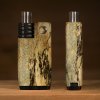Is there any idea when some nomad ii's will be out in the wild? I'm hoping to see some people thoughts on it. Maybe how it compares to a tinymight. It would be really cool to see a full assembly, usage, sis assembly and cleaning video. I just kinda wanna get an idea of the device
I hope to see some Nomad II reports soon too, but since the changes in the II are mostly toward the cosmetic end of the spectrum I expect performance to be just about the same. The heaters are identical and interchangeable (although Dan or someone else could come up with a new heater for both), the battery and unregulated nature of the device are unchanged, and as far as I can tell the electrical circuit is only slightly changed so I wouldn’t expect it to impact performance much.
That said, while there aren’t a lot of Nomads out there and there are even less reviews, here’s what I’ve seen people say:
1. I’ll get the negatives out of the way first. There are a couple of people who haven’t loved it, and I’m not sure I know all the reasons but here are the top 3 I think may have contributed.
A) The most likely problem is that if a Nomad is not used frequently it needs its contacts cleaned occasionally to maintain good performance. Some units’ contacts may even have needed cleaning when they arrived, and if that wasn’t done performance would have been significantly impacted.
B) It’s possible they could taste something they didn’t like from the heater since a small percentage of people have issues like that with a lot of vaporizers that use metallic heaters.
C) At least with the older spring-activated button (which can be upgraded) a couple of people with hand issues had trouble holding down the button.
Those are all of the negatives I can remember seeing, and they’re heavily outweighed by the positives I think.

2. On to the good! Taste tends to be rated between good and excellent, especially with the lower temp heater.
3. I don’t remember if anyone’s got 1-hit extraction down (or if anyone’s trying), but you can extract pretty fast or slowly over a long time since it’s on-demand full convection.
4. Battery life is good and especially with the II the 18650 battery’s easy to switch out.
5. On the usability instead of performance front, the Nomad is maybe the smallest on-demand convection portable with a glass (or whatever you want to use for a stem) vapor path.
It’s unregulated, but if you understand what that means and you learn how to use it there aren’t a lot of things that could go wrong. No electronics to fail, no wires to come loose, etc.
I don’t want to get too much into the TinyMight here (use the AskFC forum if you need more), but here are some obvious differences.
1. The Nomad is unregulated so the heater is just full on as long as you hold the button down and off when you let it go while the TM has electronics to heat to a specific level and stay there.
Neither of these is “better”, but the Nomad offers extra flexibility at the expense of a little more of a learning curve while regulated vaporizers are more simple for new users to pick up and go at the expense of a more complicated device that more things can go wrong with.
While the TM seems fairly solid, I’ve seen a lot more issues in that thread than here. Although Dan has offered to do things for people and he’s at least made a new sleeve for someone, I’m not sure a Nomad’s ever had to be sent back for repairs.
I don’t have my Nomad yet and I haven’t tried a TM either, but because the TM has a larger heater and larger diameter stem it should be capable of providing an even bigger single hit, but the Nomad has plenty of power too (especially with the higher temp heater) and I’ve seen more than one post in here where new users were impressed with the Nomad’s power so unless you care about fast extraction over everything else I wouldn’t choose based on this issue.
I like the Nomad’s button placement and size better too, and aesthetically...well...the TM isn’t bad and I wouldn’t mind maybe having one someday, but in my opinion Nomads are easily the best looking vaporizers out there with the most attention to detail in every aspect of every one of them. I think what you get here is worth much more than Dan asks for while most devices are...priced more favorably for the people selling them.

I think I posted a similar comparison recently too if you want to look for that, but hopefully this answers your questions.
For me the only reason for most people here with enough money not to buy a Nomad right now is the waiting list. If you need something soon I’d get a TM or something right after getting on the Nomad list so you have something to use while you wait, but if an unregulated on-demand convection artisan vaporizer is what you really want this is the place to be in my opinion.


ibb.co

ibb.co

ibb.co

ibb.co

ibb.co

ibb.co












